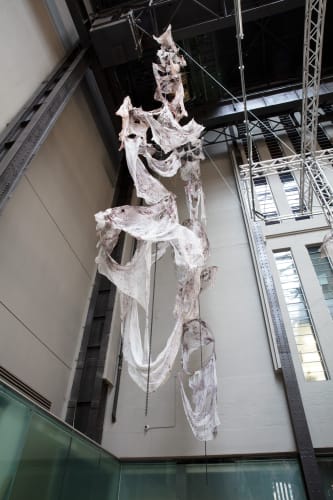Majestically grotesque, uncanny and dystopic enough to tap into our deepest unconscious fears and desires—this is how we might describe South Korean artist Mire Lee’s impressive installation for the 9th Hyundai Commission, which has transformed the Tate Modern’s Turbine Hall into a surreal landscape of hanging fabric sculptures and menacing mechanical components. Unveiled during London’s Frieze week, the installation reimagines the space as a living factory, populated by alien forms and mysterious processes. Tentacular bodies made of silicone and industrial fabric snake across the ceiling, trapped in machines or spreading like parasitic invaders.
Crafted from industrial materials like silicone, chains and eerie fluids, Lee’s “skin” installations stir complex emotions, evoking awe and disgust, desire and repulsion. Violence permeates this horrific spectacle, with the entities appearing both as victims and threats, enhanced by the striking contrast between their soft surfaces and the rigid mechanical system that holds them. Forced to convulse along with the machines, they bleed some unknown pink substance, an alien and potentially toxic secretion that threatens to contaminate the surrounding space.
In her vision, Lee presents castrated bodies—soulless simulacra of humans reduced to exhausted silhouettes, malleable membranes and inert containers devoid of individuality. Yet in their “softness” and “tactility,” they retain a seductive quality, tapping into a shared fascination with the repulsive and the alien. An unsettling tension runs through the entire installation, balancing the human with the non-human, beauty with horror and the sexy with the deeply grotesque.
This intense dialectic tension between the horrific and the erotic echoes the work of French thinker Georges Bataille, particularly in his provocative The History of the Eye(1928). In his writings, Bataille explored the interplay between eroticism and mortality, suggesting that the most profound human experiences often involve a confrontation with death. Lee’s installation resonates with Bataille’s ideas, such as those in The Solar Anus (1927): “Human eyes tolerate neither the sun, coitus, cadavers, nor obscurity, but with different reactions.”
The contiguity of eros and thanatos—extreme pleasure and extreme disgust—has also been explored by Roger Caillois as a means of transcending our physical limitations toward something closer to the “sacred.” Lee’s dystopian idol presiding over the Tate seems to embody this concept. Following this line of reflection, Bataille also argued that the civilized, industrialized world is predicated on the negation of “animality” and nature through work and labor.
Building on this thinking and drawing from the building’s history as a power station, Lee reflects on how the monumental scale of industrial architecture, like a modern cathedral to human dominance over nature, also represents our estrangement from the core of our existence. By invoking the ghosts of the factory workers who once toiled here, Lee explores the horror of intense labor—not just as a source of fear but also as a gateway to alternative possibilities, redemption and regeneration. As Lee has stated, “Ultimately, I am interested in how behind all human actions there is something soft and vulnerable, such as sincerity, hope, compassion, love and wanting to be loved.”
The excess of material and the intense sensations Lee conjures compel visitors to confront the reality of human existence. Modern man, Lee suggests, can only achieve true being by transgressing limits—whether through extreme pleasure, suffering, or their tragic representation. With the overwhelming sensation of decay it evokes, this machine constantly regulating and inglobating bodies stages the eternal cycle of life, death, and oblivion, from formlessness to matter and back again.
With this unforgettable intervention, Mire Lee has truly opened a wound: in an age where the technologies that connect us also threaten to alienate, divide and, more importantly, harm, her installation functions as a device that establishes a sense of tragedy as conceived in the classical world and ultimately unveils the veil of illusion of omnipotence over nature that has long characterized human technological and scientific development, bringing back under the eyes the inherent fragility and vulnerability of bodies and the dangerous character of our hubris.
—Elisa Carollo


